Three siblings, born in North East India in the 1880s. My grandmother and her two brothers. When their father died, the children were brought back to Scotland by their mother. The brothers would return to Raj India as adults and it would shape their lives. But my grandmother? She didn’t have their opportunities, even if she had wanted to, and became a wife and mother in Scotland.
I had almost no information about my great uncles, and they were hard to find. Here, I’m just going to describe what I know about their childhood with my grandmother, and how I found them, as one way to introduce the various Stevenson stories.
The Stevenson children
Three Stevensons were born in Pachamba, near the town of Giridih, in an area nowadays known as Jharkhand Province, and then as Bengal. Their father William Henderson Stevenson was a missionary for the Free Church of Scotland, aiming to convert Santali people to Christianity, and to provide medical and educational support, in partnership with his wife Mary McKellar Black. Over the years I’d found a fair amount about him, but next to nothing on his children, or Mary. When William died in 1888 my grandmother Bertie, his youngest child, was five years old.

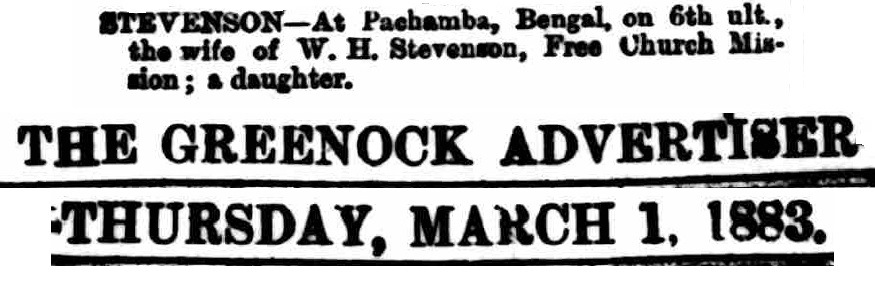
- William David Henderson Stevenson 6/12/1878 – 3/11/1945
- John Black Stevenson 18/08/1880 – 1958
- Elizabeth Bertie Stevenson 6/2/1883 – 26/12/1949
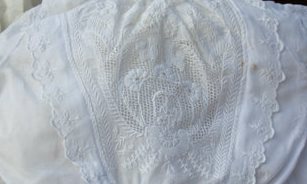
The Stevenson’s christening gown, made in India around 1880, still in the possession of the family
This group photo was taken after the children returned to Scotland with their mother, who was herself only around 36 years old. The children were aged around 9, 8 and 5.
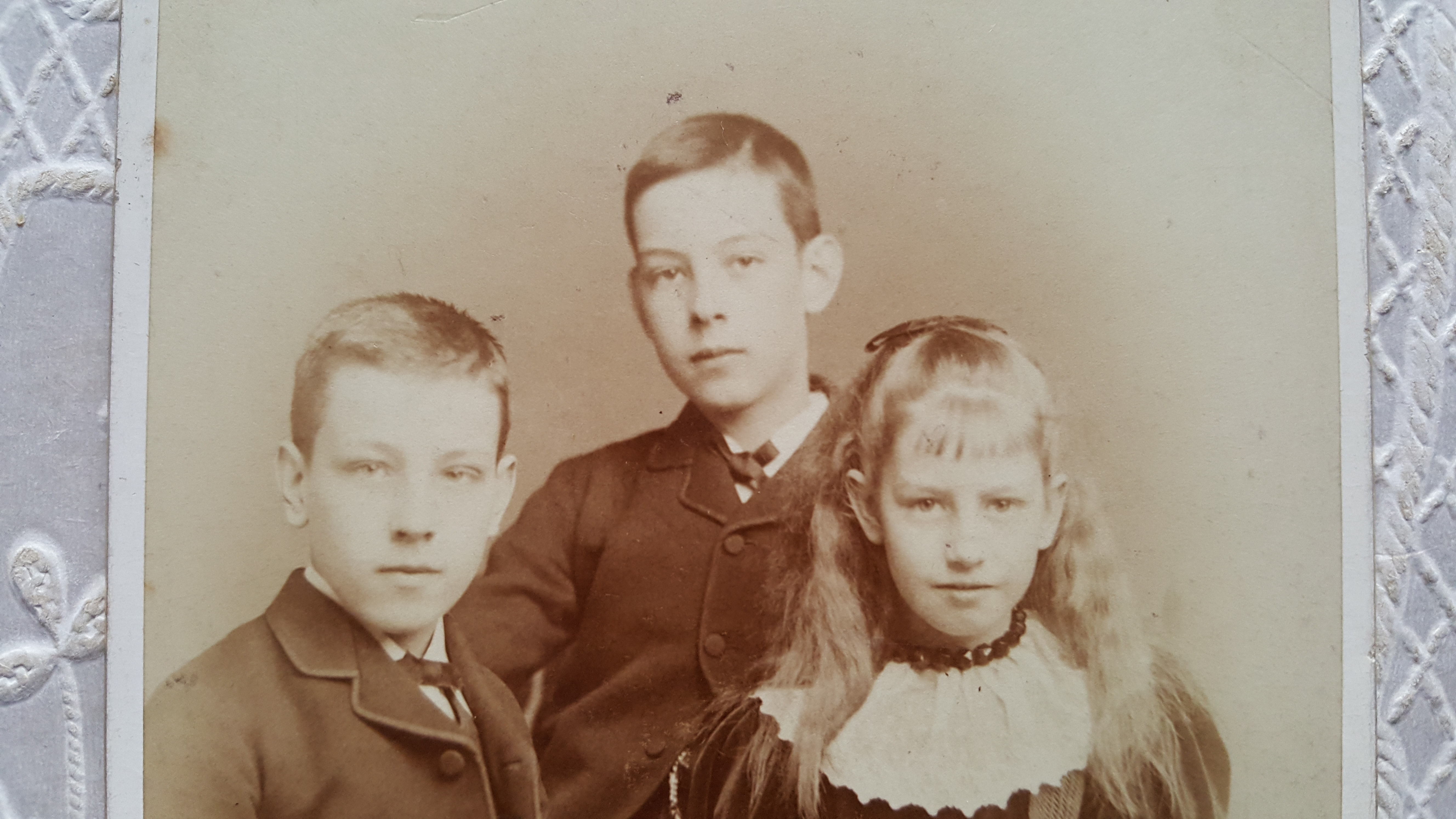
I think they’d been in Scotland as recently as 1887. For sure, their parents had visited as recently than that, because they had been fund-raising and giving talks about the mission church where they lived. I don’t know when exactly they returned “home”.
The elephant in the room
I believe that this earlier 1887 furlough trip home was the occasion William and Mary brought back with them an elephant’s tooth. It was I presume a present for the family, perhaps one of several. On the other hand, it could have been a personal memento brought back with them when they left India. Either way, it has been a talking point ever since. It is mysterious and impressive, measuring 9 inches across and weighing 4.55kg in weight (10 pounds in old money). I can see it from where I am sitting. Lots of children, over the last 130 years, have taken it to school for show and tell, and it’s one of those things with pride of place at home, for the sheer awe for the natural world it inspires.
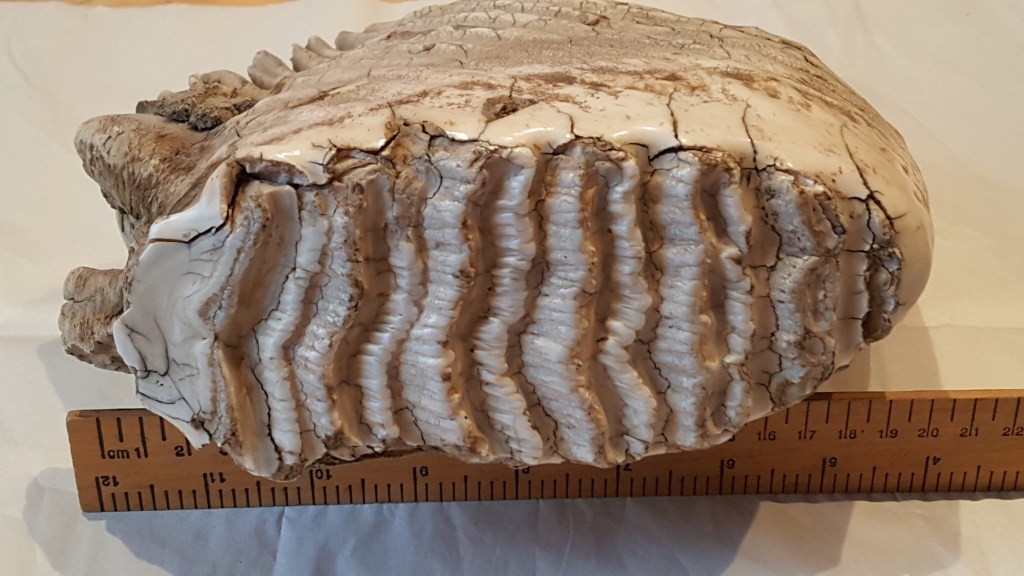
The grinding surface of the Stevenson elephant’s molar.
On returning to Glasgow in the late 1880s with their mother, the children must have undergone some kind of culture shock as well as grief. Did they think they’d be back in damp, smoggy, industrial and mild Scotland forever? Maybe: but the boys grew up to qualify as doctors, and were drawn back to Raj India as adults.
1891 in Helensburgh
Three years after returning to Scotland, on census day 1891 the family were in Helensburgh with their mother. Usefully for me, the census confirmed she was originally from Glasgow. The childrens’ place of birth clearly says Pachamba, India. The family comprised the children aged 12, 10 and 8, and Mary aged 39.
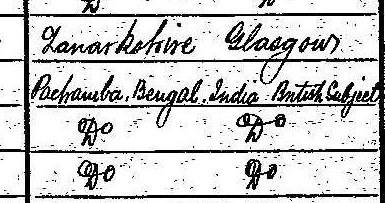
The town of Helensburgh lies west of Glasgow on the Firth of Clyde, a gateway to the west Highlands and southern Inner Hebrides. It was fashionable in the 19th century for wealthy Glasgow shipowners and merchants to build large villas on the hillside above the town: it was far enough from the city and shipyards for a comfortable life and a suburban rail line had been built in 1858, providing easy access. Though these villas are festooned with turrets and all the fripperies of fussy Victorian fashions, Glasgow book publisher Walter Blackie later bucked the trend by commissioning a world-class house from Charles Rennie and Margaret MacIntosh, the Hill House, in 1904. Scottish baronial meets Frank Lloyd Wright.
But back in 1891, the Stevensons were in a more ordinary middle-class flat down at 4 Sinclair Street, just off the sea-front, right in the centre of town. In the census, Mary was described as “living on own means”, which may well be true, but is probably a bit misleading. It presumably refers to insurance and/or a widow’s pension from the Free Church.
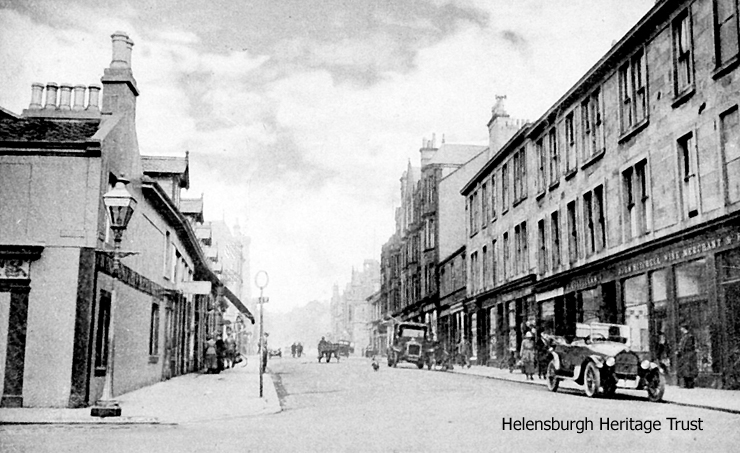
What next?
Whatever their financial situation, the Stevenson siblings were able to fall back on their social privilege. No doubt due to talent and ambition, they were to make excellent use of the opportunities they were able to access in part due to the respect their community felt for their father. They connected with families that were or became successful, comfortable and autonomous. They worked hard, did well and “married well”. They passed the privilege on.
But despite the anachronism, I think of John Irving’s menacing Blue Mustang roaming the quiet comfortable streets of Helensburgh. Just a glimpse of something disappearing round a corner. You can’t avoid Fate, but the inevitable is unpredictable, and in the meantime you things can be very comfortable for some.
Everyone sees the Blue Mustang out the corner of their eye, sometime. Coming for my great uncle Percy, who would be born in 1893 and not survive his teenage years. For my great uncle Dr David McKenzie Newton (and father of Bertie’s niece Elizabeth), also a missionary, who also died far from Scotland when treating the sick. (That story appears at length elsewhere). And in my great uncle Jack’s story, for example, there’s a stretch of road at Clayton Hill in Surrey that is lying in wait some four decades into the future. Across and down, a family tree teaches you that there is always something. With a date and a place noted neatly alongside the name.
Who was my grandmother?
I never met my grandmother, but when starting to prepare this post I knew more about her than her brothers. Well, on paper. I knew when in 1883 she’d been born, and that she died on Boxing Day in 1949, aged 66. I knew too about all her 11 grandchildren, 26 great grandchildren, and 18 to date from the most recent generation. A generation which began in 1998.
But personally… I have only this: my siblings and I maintain the tradition of getting together with each other and as many of the younger family as possible on Boxing Day, something which had previously been a tradition for my father and his sisters. (Just maybe its origins pre-dated their mother’s death). It’s a great day for a get-together, and we should really be toasting her memory in appreciation. She is already featured on Noisybrain, e.g. in 1913, because is is my recent ancestor and I have lots of photos. But as I say, I don’t have any sense of her as a person, even at second hand, unlike some of my cousins (who are all older than me).
Her early childhood in India… what was that actually like? Did she want to return? What was the effect of her traumatic childhood experience? I don’t think anyone can answer those questions. The only sense I have gained is of a serious, sensible and perhaps strict person, typical of her generation. Emotionally? I feel I am imposing a sense of loss rather than confidence or composure, but I can’t avoid it.
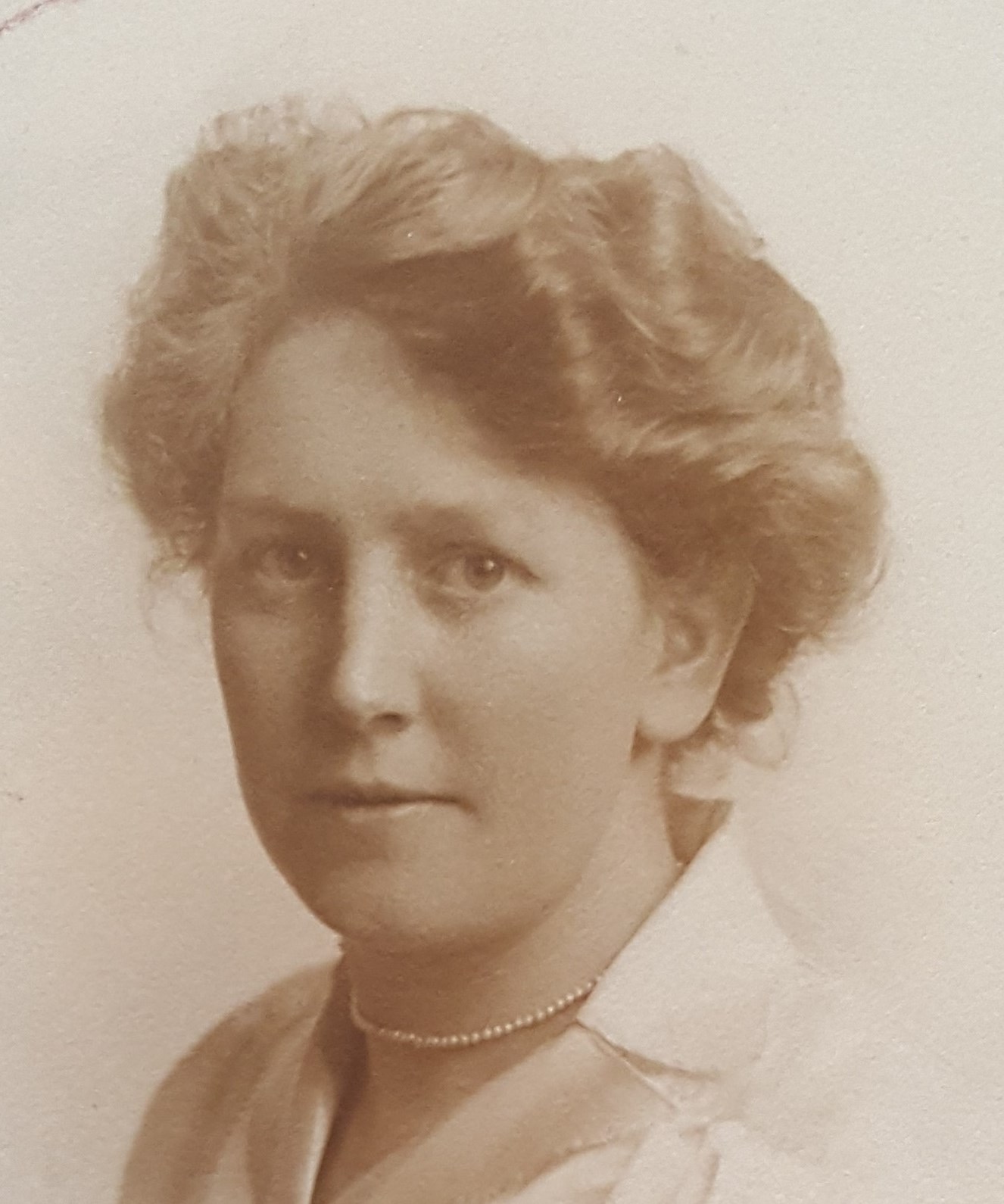
Now I have done the research, I now know more facts and figures about her father and brothers than about my grandmother herself. So little information was preserved about women and their activities, compared to men. Women had limited choices in employment and public life, so it is much easier to associate them just with child-bearing or child-rearing, and without something more than BMD and formal posed photographs, there is not provide much opportunity for personal insight.
The Stevenson family home in Rutherglen at the time of Bertie’s wedding in 1909 was called “Pachumba”, showing how much their origins still mattered to them.
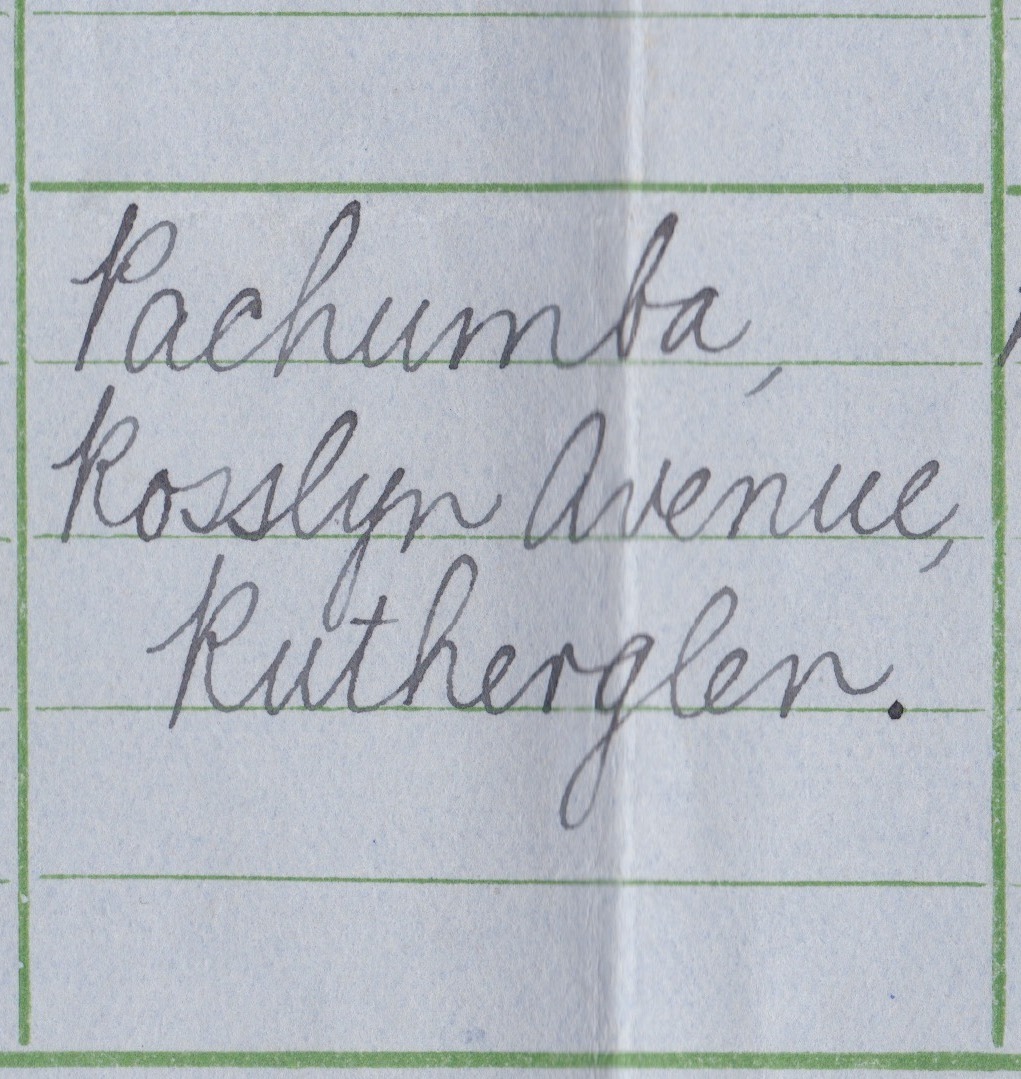
Not finding the right Stevensons
I am spoilt, I admit it. I have old photos, good stories to tell, some great records of who did what, and a previous family historian on my father’s side (Elizabeth Mitchell). I usually have unusual surnames to make the research easier. Interesting objects. And best of all, variety.
So I was not used to the Stevenson problem. Despite being close relatives, the Stevenson brothers, my great uncles, were tricky to trace. Some family notes were vague or not quite accurate. I had no birth records, and was uncertain about middle names. All three siblings had been born in India and the brothers hadn’t died in Scotland. There were a lot of people called John Stevenson and William Stevenson at that time, some with a sizable internet footprint. So, there were multiple potential leads. Too many namesakes. Being spoilt, my impression was that there were just too many people with similar names, especially when looking furth of Scotland… and also I was (and remain) not so familiar with non-Scottish records. So… onto the back-burner they went.
On the other hand, their father (the missionary)… What about him? His story is a great one, but it’s dauntingly big, so every now and then I find out yet more about him. Back-burner for him too, for years now. An occasional search for their father did always seem to produce something new, though quite a lot of it was off-puttingly dull press reports of kirk activity.
I was doing newspaper archive searches (in Canadian papers) late in 2018 and casually surf-searching for the missionary William Henderson Stevenson, when… Oh thank goodness for the ever-expanding web, for the passage of time, and for shared middle names. The great uncles finally were right under my nose.
Indian rellies
Glasgow University had decided to promote its credentials in a set of “International Story” web pages, listing alumni with biographical notes. For privacy reasons, they focused on those who graduated more than 100 years ago. Now… Glasgow, Edinburgh and St. Andrews are the three most ancient Scottish universities, and were for long enough three of only five universities in Great Britain. They can be very proud of their history (Glasgow was founded in 1451), and the huge number of contemporary students and staff who area international are central to their success, and a crucial part of the whole sector. But they had taken their archive information on alumni somewhat literally. They just have names, locations, and dates, after all. Not stories.
A large archival project had began in March 2012. The Commonwealth Games was coming to Glasgow in 2014, another good reason to promote the “rich heritage of pioneering international students and staff”. Tell some stories. Collate nationalities of origin. Maps, photos, a nice searchable interface. And it really is nice! It’s worth a browse.
But maybe you can guess why this was useful to me.
Yes! The list of International Alumni included my two great uncles, hyperlinked together. Badged with Indian flags. Also, an English flag for William, since they had a record of his death there. Clearly the right people, and with dates of birth as well as their degrees and graduation dates! Even with places of death and mentions of army service. Proof that the formal name of “Jack B” was John Black. Brilliant. But… “international”‽
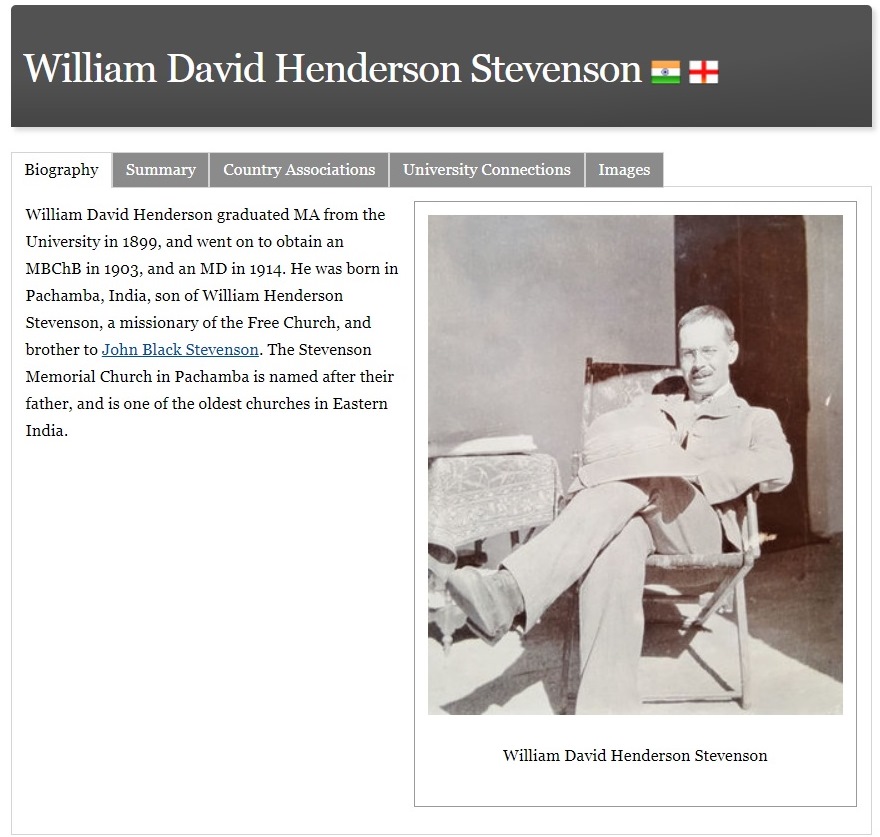
I contacted the very nice archivists in late 2018, corrected them on some points of fact/transcription where I could (e.g. suggesting changing Patchamba to Pachamba, and telling them that Chamba is an entirely different town somewhere else). I sent the photo above (note the cheeky pith helmet on the knee) from William’s adult life and work in India, from our personal family collection. William’s page (above) now features some pithy biography (boom boom).
I did mention, gently, that these were Scottish boys, who were born to a Free Church of Scotland missionary in the days of the Raj, and who returned to Scotland for much of their childhoods. I was a bit nervous that if I made this comment too plain, they’d be removed from the site! At the moment (early 2019) they are still there online, though they are hardly canonical representatives of international students, in the sense that might be desired in relation to the website’s intended purpose. They’re not alone, judging by appearances. I hope they don’t disappear, because what I’ve found since confirms that they were indeed international (meaning that I assume they held the more benevolent types of colonial perspective for their times).
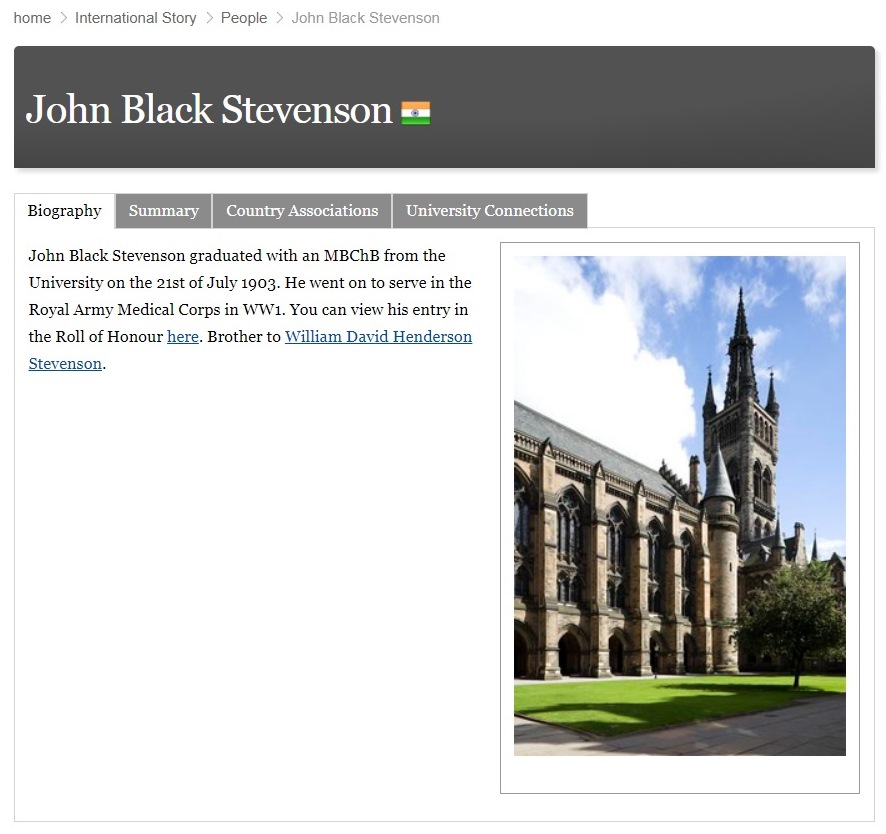
Of course, this was a brilliant find from my point of view, and their dates of birth in particular have led to further discoveries in the last few months, since then I knew exactly which of the many, many Stevensons I was looking for. More of that soon.
- Jack is here with his wife (also born in Scotland), who married in India.
- Jack’s wife’s ancestors and siblings etc… cousin-bait… are here.
- The link from William’s wife Mary Morris to the physicist Stephen Hawking is explored here.
NOTES and SOURCES
The University of Glasgow Story website has the names of graduates of the University up to a hundred years ago. It was launched in 2007. See the about page. The university gives information only relating to graduations that occurred more than 100 years ago to protect privacy of graduates. Older information is limited because for centuries study was not regulated as it is nowadays. But after 1858, information gathered and retained was a lot more comprehensive. The archivists note “In 1858 the Universities (Scotland) Act made matriculation compulsory. Therefore if a person’s name, or any variations of their name, cannot be found, they were not a student of the University of Glasgow. They may, nevertheless, have studied at one of the several other colleges and Universities in the City.” (Quotes and data from various pages accessed October 2018/March 2019).
The University of Glasgow archive has contributed data reproduced in various books, some available online from them, here. These, or physical archives that can be visited in person or searched by staff, might provide information on students, graduates, staff, and ministers of religion.
Specifically, the University of Glasgow’s Registrar’s Roll of Graduates and Dates of Birth (R3/1/1) was very useful here, because it has dates of birth of graduates which they used in their International Story. “This source is a book that contains three separate lists of graduates in alphabetical order. In most cases their full dates of birth as given to the University Registrar at time of graduation are recorded however there are some for whom no date of birth is noted and for some there is only a partial date. The front cover of the book refers to the three alphabetical lists as three volumes which together cover the period 1881 to 1915. This reflects the fact that there are a total of 16 volumes in the series covering to 1946.”
And there’s more. Since then, some serious reflection has started to recognise and maybe deal with genuinely important issues, like the role of slavery in the creation of Glasgow’s wealth and the ethical implications for the university of gifts and bequests. Wealth means patronage. It enables education and advancement, initially for the few and then through benefaction and spreading prosperity, to more than a few. And the flip-side to the wealth of the Scottish Tobacco Lords, and the later waves of wealth arising from the Industrial Revolution… well. From school, I recall a limited perspective, focusing on grand buildings and the sponsorship of education, art, philanthropy, charity, proselytism. Progress. The Enlightenment. I do not recall a clear connection being made to slavery, poverty, ill-health, pollution, or revolution. Empire and colonialism seem like ancient history to some, but this is simply wrong. They not even recent history yet, if history is the domain of the dead. Who wants to forget so fast, and why?
Anyway, Glasgow’s International project now links these issues, adding to more traditional interests in the impoverishment within Scotland so central to the creation of wealth and imperial power. In 2017 the University of Glasgow became the first British University to join the international consortium of Universities Studying Slavery.
Great Uncle Willie is WH22115 in Glasgow’s “international story” at
https://www.internationalstory.gla.ac.uk/person/?id=WH22115 and Uncle Jack is WH22112 https://www.internationalstory.gla.ac.uk/person/?id=WH22112 – and even still in 2021 both are still labelled with the Indian flag in this international story site. William still also features the English flag (though both lived in England). In addition, William in the international story has a link to Jack, and Jack has a link to William… but though William’s page has the same content as in the international site, actually it’s in the more general “university story” wrapper website, at https://www.universitystory.gla.ac.uk/biography/?id=WH22115 – you can therefore also access non-international Jack at https://www.universitystory.gla.ac.uk/biography/?id=WH22112 and despite the usefulness of this information, William’s birthdate was still in error in mid 2021 (as 6 December 1879, when it should be 6 December 1878).
Helensburgh Heritage Trust http://www.helensburgh-heritage.co.uk/
GENI.com has some tree information for my Stevensons.
All my original personal images and my text are protected under an international Creative Commons 4.0 BY-NC-SA license issued by me, James M Scobbie. See the home page.
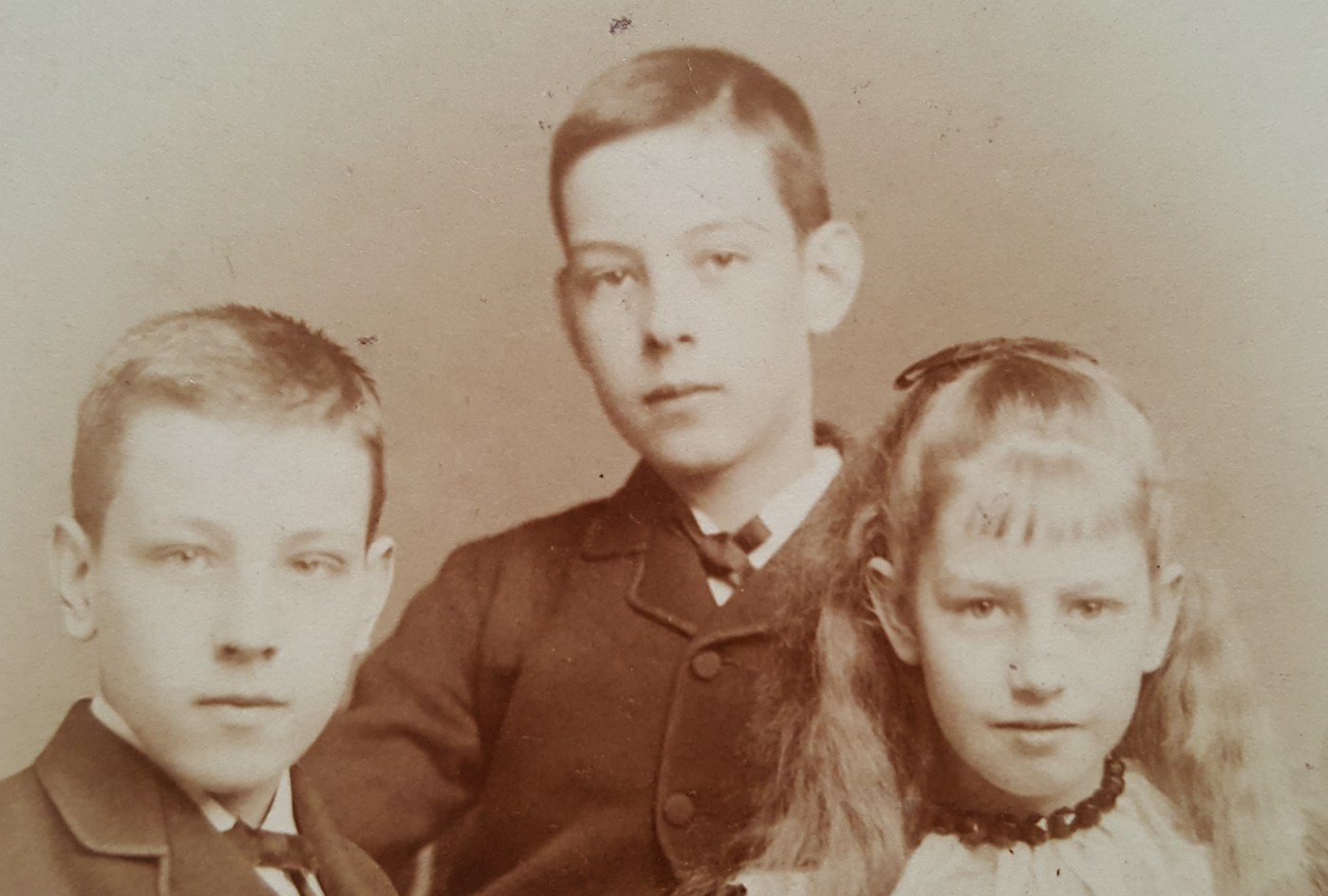
Hi Have you tried FIBIS.org, Families in British India Society. They have an excellent database and are very generous with their resources. For example I found the following marriage that may be your great uncle Jack: notice in the Times of India
Grooms Surname Stevenson
First names John Black
Brides surname Simpson
First names Marie
Place Jalna
Year 1907
month Apr
day 4
Register Entry April 4th at Jalna by the Rev A Campbell DD Santalia assisted by Rev J Douglas MA and Rev R B Dougla…
Edition Year 1907
Regards
Anne
LikeLiked by 1 person
Yes, thanks, I’ve looked at FIBIS and have my post on Jack’s life mostly written and ready to go. I came across FIBIS only recently – about a week ago – and was *really* confused when I saw this wedding announcement – because of “Marie”. You’ll see why, in my next post 🙂
LikeLiked by 1 person
Look forward to the next post 🙂
LikeLiked by 1 person
likewise!
LikeLike
Wonderful piece. Enjoyed very much
LikeLiked by 1 person
thanks so much!
LikeLike
Great story!! Thank you.
LikeLiked by 1 person
Glad you liked it, thanks for your comment.
LikeLike
Great research Jim. The tale of WDH Stevenson my grandfather and his brother and sister is enhanced by the oral tradition from my mother Janet Audrey Mary Margaret Morris (née) Stevenson who emphasised their poverty and that my grandfather worked and got scholarships to get him and his brother through medical school. I mote your identification of them as Privileged but the story I got was poor but honest gentlefolk fallen on hard times because of the death of the first William fighting cholera amongst his poor paritioners . I got the impression he married down with my grandmother Mary Walker who was from a wealthy but ‘nouveau riche’ family, her father making his money from scrap metal on the Clyde and then moving to Bearsden. Any ‘privelege’ was a class and educational thing, but hard work and thrift pulled them through.
LikeLiked by 1 person
Yes I agree, and I am partly adopting a slightly more contemporary use of privilege: the brothers had choices their sister did not. More, they were able to get a university education, unlike most men. They must have had a hard time of it, I am very sure, as you say. Hard work and talent shine through. It’s good to hear also of their support systems of family and scholarships. By “privilege” I don’t mean to imply a cushy context, or an easy life.
LikeLike
I can’t wait to put more online about WH Stevenson the missionary, our shared 2x great grandfather! And to see if that jogs any memories. We are lucky to have some verbatim descriptions of his conversation, and a story of his childhood, in print. And nice words about him from contemporaries.
However for WDH Stevenson I will be more reticent, going for the bald CV approach…! It is a very very impressive one. You perhaps would consider doing the stories somewhere. I hope you do. He must have been an inspiration.
LikeLike